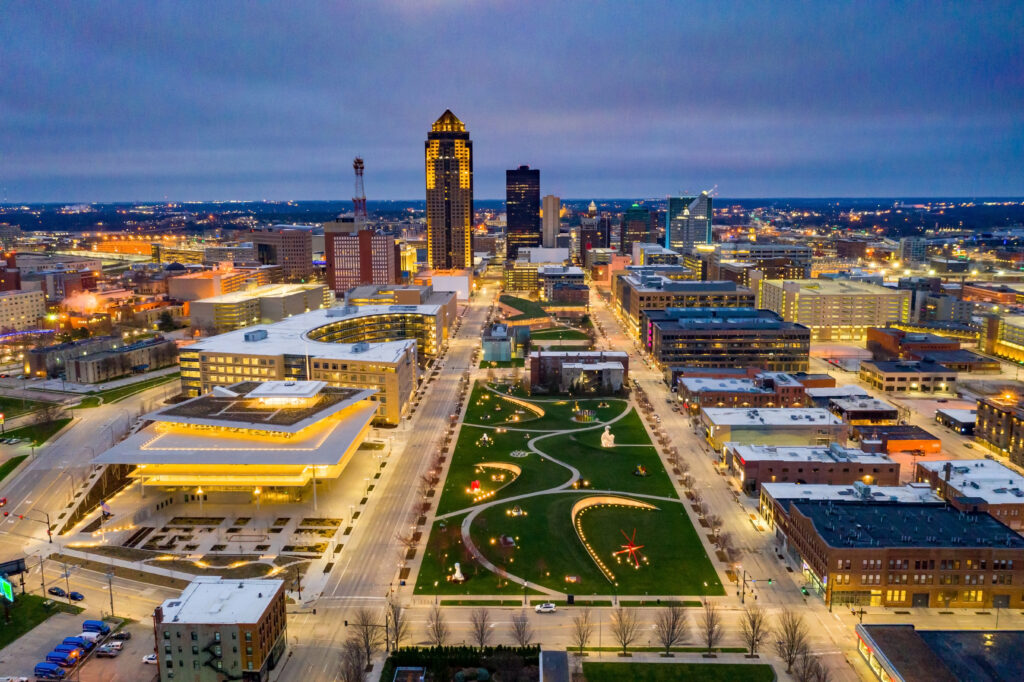Des Moines: The next generation
Work on new comprehensive plan forces introspective look at issues, needs

PERRY BEEMAN Jun 5, 2015 | 11:00 am
11 min read time
2,651 wordsBusiness Record Insider, Economic DevelopmentDes Moines is a mature, medium-sized city.
That comes with some challenges.
Combine the flight to the suburbs, brain drain, a shortage of skilled workers, the financial stress that comes with 40 percent of the land being tax-exempt, the stresses on graduation rates for the city’s diverse student body, and the challenge of improving mass transit during tight budget times, and there is plenty of work to do.
Yet, as the city works on its latest comprehensive plan, called PlanDSM, things are definitely looking up. Downtown Des Moines is in at least its third full-blown boom of the past three or four decades, and perhaps the first in which housing was fully front and center.
The city has looked not only to become more friendly to pedestrians and bicyclists, but also welcoming to startup businesses, innovators, food trucks, artists and performers.
The new comprehensive plan should be ready by early 2016, with a new zoning ordinance less than two years later. Phil Delafield, Des Moines’ community development director, said drafts will be presented in public meetings.
The work comes down largely to one question, said Mayor Frank Cownie: “How is it that Des Moines can be a great place to live and raise a family and to have a job?”
The comprehensive plan is an important exercise that can help shape life in Des Moines for the next 25 years. We decided to take a closer look at the issues the city is trying to address as it comes up with a vision for Des Moines 2040.
Downtown housing, restaurants, hotels and bars are spreading south of Martin Luther King Parkway and both north and south of the East Village. Des Moines neighborhoods are once again loudly calling for improvements to restore urban alternatives to the suburban march toward Omaha and Winterset.
“We are already urban,” which is what many residents want, said Delafield. “We should play to our strengths.”
The city already has been on a bit of a planning frenzy as part of metrowide work on housing, transportation and economic development (see Housing Tomorrow, the Tomorrow Plan, Capital Crossroads and the Cultivation Corridor, for starters). Now, the Des Moines City Council is looking inward, at the state of the city, trouble spots and the hope for the future.
The city developed its first plan in 1909 and adopted its first comprehensive plan in 1928. It’s been updated four times, most recently in 2000. The latest version, called PlanDSM (https://plandsm.dmgov.org/), may be the most ambitious. The city has assembled key stakeholders from real estate interests, the schools, the Des Moines Area Metropolitan Planning Organization and neighborhoods for this round.
“The city of Des Moines wants to do a localized version of the Tomorrow Plan,” said Todd Ashby, executive director of the Des Moines Area Metropolitan Planning Organization. “Do the ideas fit?”
Delafield said the planning exercise will help decide what Des Moines looks like in 20 or 30 years. “In many ways, this sets the vision,” Delafield said. “The comprehensive plan sets the values and the priorities, on housing density, transportation and parks, for example.” Then the city builds a zoning apparatus to get to those goals.
That could mean, for example, looking to make neighborhoods more walkable, and checking to see whether it’s convenient to stroll to a bus stop, Ashby said. And it will likely mean considering the changing transportation needs in a population with its share of baby boomers now marching full speed into senior citizen status.
“The transportation needs will be different by choice, and by need,” Ashby said. People are driving less, statistics show. And, baby boom aside, the younger crowd is even more prone to walk, ride a bike or take a bus to get around.
“Cars aren’t going to go away, but how we use them will change,” Ashby said.
Elizabeth Presutti, general manager of the Des Moines Area Regional Transit Authority, said part of the debate will be where to locate affordable housing, something the Polk County Housing Trust Fund examined in the new Housing Tomorrow report.
“Do you put it out in the middle of nowhere with no services, or next to a (transportation) corridor?” Presutti asked.
Higher-density development helps attract services and makes it easier to provide bus transportation, she added.
Housing by the numbers
Though Des Moines has more affordable housing than many of the other cities in Central Iowa, it needs more, according to the Housing Tomorrow study compiled by the Polk County Housing Trust Fund. Here’s a look at the city’s housing stock by the numbers.
46% – The percentage of Des Moines’ homes that are at least 50 years old.
One-third – The proportion of homes that were built prior to World War II.
1945 – The average year a home was built in Des Moines.
1973 – The average year a home was built in the suburbs.
93% – The percentage of Des Moines homes, in the assessor’s opinion, that are in normal or better condition.
1,125 – The average square footage of Des Moines homes, a figure smaller than homes tend to be in surrounding areas.
25% – The percentage of homes in Des Moines that are less than 850 square feet.
Recreation offerings important
Recreation becomes a powerful draw, and the MPO is working on a water trail plan for Greater Des Moines in cooperation with the Iowa Department of Natural Resources. Water Works Park — an underused expanse bigger than New York City’s Central Park, and right across Fleur Drive from the extremely popular Gray’s Lake — is about to get an overhaul that could include:
• An art-adorned Fleur Drive underpass between the two parks.
• A venue for small outdoor concerts, a multipurpose lawn area, a 2-mile recreation trail around a pond that would connect to Gray’s Lake, new gardens and a restored arboretum.
• Long-term plans include canoe access to the Raccoon River, a channel in the park that would be part of a new wetland installation, deepened ponds meant to clean water before it is treated for drinking, another concert area, a new pedestrian bridge and docks.
‘Complete streets’ eyed
City leaders, especially Cownie, have pushed the idea of “complete streets,” a concept that involves narrowing some roads to make them safer, plus adding bicycle lanes and walkways meant to encourage walking.
“Cities used to be designed with the corner grocery stores and local hardware stores and the bakery and park right there,” Ashby said.
The city has 400 miles of streets that would be prospects for bike lanes, Ashby noted. The MPO want to push for those additions, because many residents don’t want to take the time to fight through rush hour in a vehicle.
“Time is a bigger issue, not so much the drive,” Ashby said. “People don’t want to spend a half hour getting somewhere,” he added.
The flurry of high-intensity planning efforts will help Des Moines in the long run, Ashby said.
“Residents want these things,” Ashby said of walkable neighborhoods, expanded mass transit and better recreation. “On a national level, if we want to be a player, we need to do these things to keep the community vibrant.”
The Tomorrow Plan, coordinated by Ashby’s organization, envisioned Greater Des Moines’ morphing into a more diverse area with more walkable neighborhoods, better mass transit and more affordable housing.
What type of city?
Many times city comprehensive plans focuses mainly on a broad look at what types of development will go where, and guide changes in zoning regulations to bring the new vision. Cownie has made no secret of his disappointment that the last round didn’t result in the nuts-and-bolts changes to city ordinances to implement many of the ideas.
City leaders seem to view this plan as a truly comprehensive look at the city, including the schools, which are run by the independently elected Des Moines School Board.
Superintendent Tom Ahart said the city and school districts are looking for ways to work together to better neighborhoods. “We’re looking to building communities within communities, ideally,” Ahart said. “That is a natural blending of goals.”
Developing activity areas
Much of the work will look at how the city can develop concentrated areas of activity. That could mean a large shopping center and surrounding area, such as Merle Hay Mall, or a smaller corridor, like Sixth Avenue north of downtown.
Rick Tollakson, president and CEO of Hubbell Realty, also is on the PlanDSM steering committee. Not surprisingly, he’d like to see a new Des Moines that provides for a diverse blend of housing options in neighborhoods.
“We need to be offered more flexibility, and zoning so developers can go in and not get hammered by the neighborhood,” Tollakson said. “If nothing changes, nothing gets better.”
“We want to see mixed use,” with everything from ranch style houses to townhomes and apartments, he said.
“We need housing, transit and new jobs,” Tollakson said. “What do we want our neighborhoods to look like? How are we going to revitalize neighborhoods, and how do we do that with product? The guy with the $200,000 house doesn’t want a $100,000 place next door. In Des Moines, the housing is aging, and it’s the least diverse.”
“It’s an exciting time for Des Moines,” Tollakson said. The comprehensive plan is “a good thing to help with the strong resurgence in downtown and in the neighborhoods.”
Delafield said providing more dense housing areas, especially along bus routes, could help the city. So could more housing choices. But he said diverse housing offerings may be easier along major roadways than in the middle of stable residential areas, where residents may object to, say, an apartment high rise.
Current land use, zoning in Des Moines
Percentage of acres in residential and commercial development
-51% Residential
-17% Parks/Open Space
-15% Commercial
-8% Public/Semi-public
-6% Industrial
-3% Agriculture
Percentages of the city that are listed for various uses, based on the zoning in place now.
-53% Residential
-14% Agriculture
-12% Industrial
-8% Commercial
-8% Floodway
-4% Floodplan
-1% Planned Districts
Making development easier
The city has for decades received heat from developers who want to get construction permits faster. Some of that has to do with coming up with city codes and zoning ordinances that clearly allow a range of housing in certain areas and make it easier to gain approvals, Delafield said.
“The need for a diversity of housing is the most important piece we have to address,” he said.
“Developers don’t like the unpredictable,” Delafield said. “They want us to reduce process, and to make it more clear.” They also would like the city’s 180-day turnaround on permits cut in half, he added.
Downtown is a successful example. “The zoning is broad, and there are no parking requirements,” Delafield said. “It entirely possible to do whatever your vision is.”
Schools plan for growth
The Des Moines school district has been systematically upgrading the facilities a school or two at a time, and has floated the idea of a football stadium at the Superfund site that once was DICO’s plant site south of downtown near Fleur Drive and Martin Luther King Parkway.
Graduation rates, a perennial area of concern, are up. The district is turning 50 kindergarteners a year away from the popular Walnut Street School, and looking for ways to serve more.
Ahart said the district continues to work through the challenge of educating students from 88 countries, who speak 100 languages. The district has offered meal programs and other services while coping with the fact that a large majority of the students are in poverty, defined as qualifying for free or reduced-price lunches.
The comp plan is important because it could drive development that will mean more schools are needed, Ahart said. He added that Hubbell Realty’s planned Bridges district near I-235 in the old River Hills area, and the addition of a full-scale grocery store along Court Avenue both could mean downtown attracts more families. That, in turn, could mean a need for more schools.
“It’s a whole different equation in an established urban climate like Des Moines,” Ahart said.
Said Delafield: “The school district does an amazing job. They are maligned unfairly.”
New urban offerings
Delafield said Des Moines has started to see pressure for new offerings. For example, downtown’s 8,500 housing units are largely occupied by single professionals and empty nesters.
But more people wonder if they could move up into bigger digs downtown eventually, perhaps south of downtown or in the former River Hills office area that Hubbell Realty Co. plans to develop.
Around the city, there is talk of developing “nodes.” That’s planner speak for areas like Highland Park, Sixth Avenue, the East Village and Beaverdale, where you won’t find a regional mall, but you will find clusters of retail shops, jobs, parks and other things those same planners might call urban amenities.
A string of national speakers in Des Moines have delivered similar messages: Des Moines would do well to develop more bike lanes, make it easier to walk to work or to the store, and maybe even make streets narrower instead of wider.
“How do we make walkable areas, transit, autos and bikes work together?” Delafield asked.
Cownie points to Ingersoll Avenue as a good example of that type change, one that made it safer, more bike-friendly and better for motorists who were skeptical, to say the least.
Life in Des Moines
A look at the city’s existing conditions
Lack of growth
Des Moines, Iowa’s largest city, gained 5,538 people between 2000 and 2010. That was a 2.8 percent increase, to 204,220. Many will see that growth as a plus, but it points to some trouble. For starters, the city was actually bigger in 1960, when the population hit a record that still stands: 208,982.
The average Iowa city grew 4.1 percent in the period. Nationally, the average city grew at more than three times the rate of Des Moines, at 9.7 percent.
Des Moines lost population for 30 years after the 1960 record, bottoming out at 191,003 in 1980. Then the capital city grew close to the record, 207,510 in 2013. Planners expect a new record to come by 2020, although the city clearly is not growing quickly.
Schools
The Des Moines school district has faced challenges of updating buildings, attempting to boost graduation rates, and fighting perceptions that lead some real estate agents to steer clients to the suburbs. In 2012-13, the district had a graduation rate of 79 percent, 10 percentage points below the state average. However, the district has reported gains in recent months, citing special programs and offerings at Central Academy and Central Campus as reasons.
Diversity
This is a challenge in providing proper services, but also is seen as a strength to many. Between 2000 and 2010, the Latino population grew more than 85 percent in Des Moines, about the same as the state. The African-American population grew 44 percent in the same period, and the Asian population, 29 percent.
Des Moines is gaining population in some minority groups, but still 68 percent of residents were born in Iowa. Of those born outside the country, 44 percent are from Latin America and 32 percent from Asia.
Latinos represent the largest minority population in Des Moines. In 2010, they accounted for 12 percent of the population, with African-Americans at 10 percent and Asians, 4 percent.
Age
Des Moines residents have a median age of 33. Statewide the median is 38, and nationally, 37. There are signs that services to the young and to senior citizens will both be important. Seventeen percent of Des Moines residents are over 65, slightly more than the state average, and 17 percent are of school age.
Parks
Some 4,000 acres, or 7.6 percent, of the city is in parks. The Trust for Public Land’s national study found that park acres in other cities ranged from 2.2 percent to 33.0 percent, with a median of 9.3 percent.









